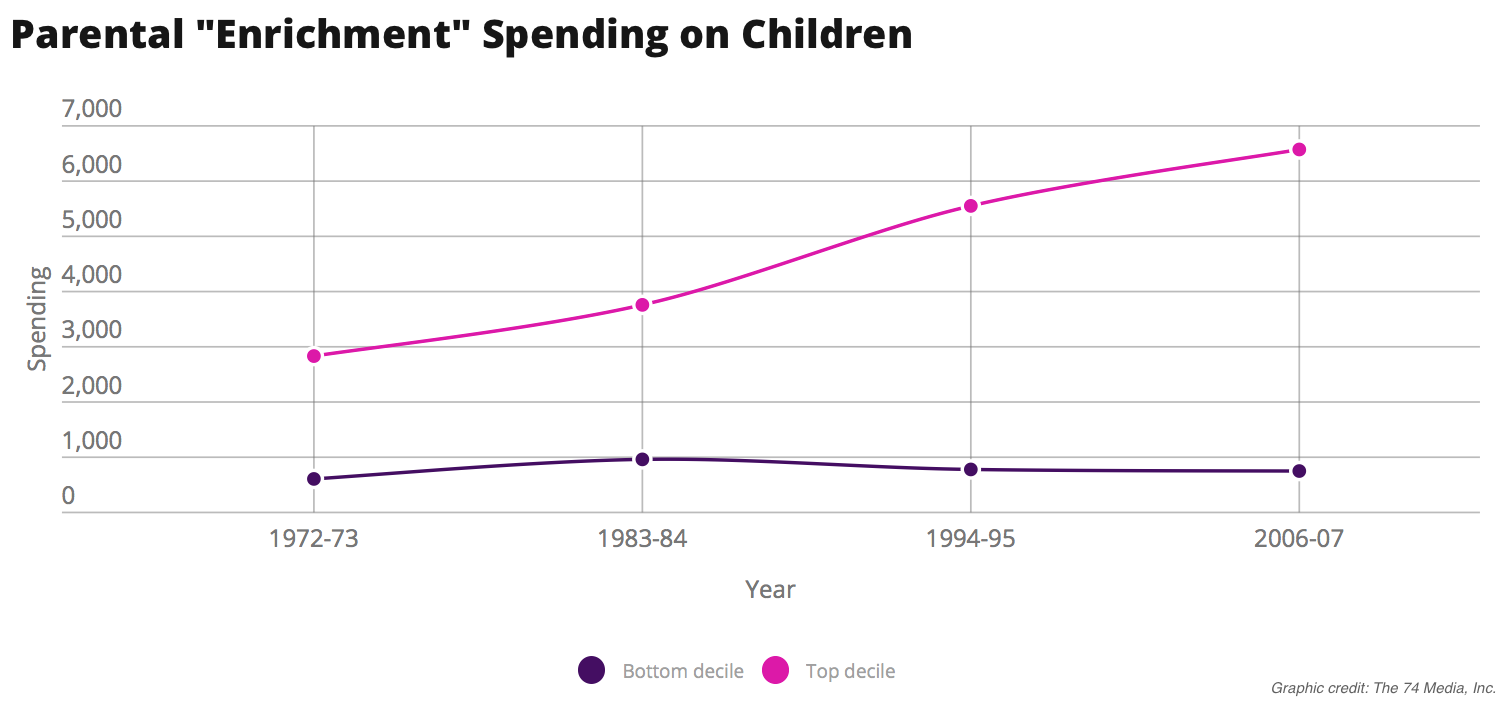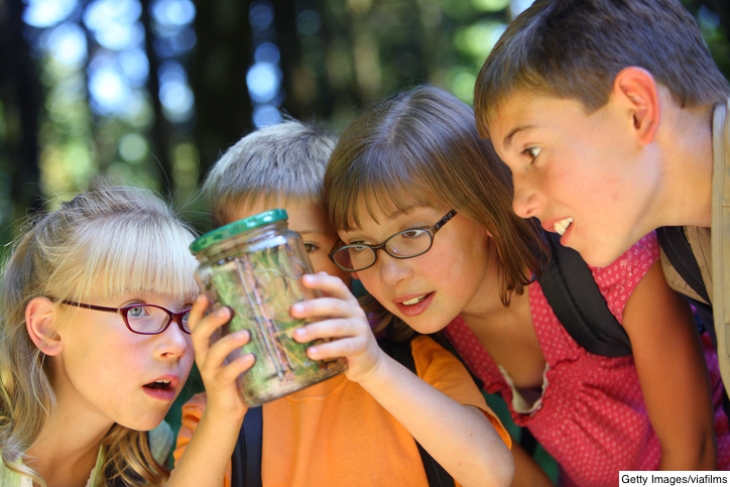Late July might be famous for potato chips and trips to the beach. But it’s also the time when America’s inequality, like the hot summer sun, is at its zenith, particularly for our children. Affluent kids are spending their days (and often their nights) at camp or traveling the world with their families, picking up knowledge, skills, and social connections that will help them thrive at school and beyond. Needless to say, these experiences are seldom accessible to their less affluent peers.
As Robert Putnam argued in his landmark book Our Kids—and again in his recent report, Closing the Opportunity Gap—there is a growing class gulf in spending on children’s enrichment and extracurricular activities (things like sports, summer camps, piano lessons, and trips to the zoo). As the upper-middle class grows larger and richer, it is spending extraordinary sums to enhance its kids’ experience and education; meanwhile, other children must make do with far less. (Putnam got the data for his chart from this study.)

More critically, that gap shows up in participation rates too. The Census Bureau tracks involvement in out-of-school sports, clubs, and lessons (e.g., music, dance, Hebrew). Here’s what sports participation looks like for children ages 6–11 broken down by parental education level, a good proxy for social class:

As is evident, not every first grader plays soccer, even if that feels like the suburban norm. Children whose parents have advanced degrees are three times likelier to participate in sports than those whose parents dropped out of high school. The picture looks much the same for clubs and lessons, as well as for high school students’ involvement in extracurricular activities.
These are enormous differences. As Annette Lareau pointed out in Unequal Childhoods, affluent kids are scheduled to the hilt, while poor and working class kids’ spare time is largely self-organized. Though that kind of “free range” experience brings some benefits, it also means less intellectual stimulation, social development, and basic safety for the have-nots. Years later, the “overscheduled” kids seem better able to navigate college and the adult world. (Of course, they’ve also had other advantages.)
After school, over the weekend, and during summer are also great times for kids to work on their “identity projects”—a term coined by Stefanie DeLuca, Susan Clampet-Lundquist, and Kathryn Edin in their recent book, Coming of Age in the Other America, to refer to passions that propel children to long-term success. Such projects usually take the form of artistic, creative, vocational, and enrichment activities that give young people meaning and direction (and the option of not being on the street). As DeLuca told me in an email, these pursuits “sparked the grit to stay in school and avoid trouble, and select into better peer groups.”
A growing body of research attests to the positive impact of participation in extracurricular and enrichment activities. The evidence is particularly strong for high school athletics, where a handful of studies have been able to establish a causal link between participation and positive long-term outcomes. The most prominent is a brilliant analysis by Betsey Stevenson that examines the impact of Title IX on girls’ participation in high school sports, finding a significant increase in college going and labor force participation. A trove of correlational studies have also demonstrated benefits for high school athletes, including higher grades, increased graduation and college completion rates, and a decrease in various antisocial behaviors. There are similar results for students who participate in other extracurricular activities, such as clubs, especially if they play leadership roles or are deeply committed.
There is somewhat less evidence pointing to the benefits of enrichment activities for younger students; as far as I can tell, no one has established a causal link between enrichment and long-term outcomes. But there’s plenty of correlational as well as anecdotal evidence. Scholars have mostly looked at after-school programs. There, too, they find a correlation between participation and positive outcomes, at least when attendance is regular and there’s a strong connection to an adult role model.
What explains the connection between enrichment activities and student success? We cannot be certain, but mentors are surely part of it. So is the development of those “non-cognitive” and “social and emotional” skills that have everyone’s attention. Sure, you can try to teach “grit” in math class (though there are reasons to be skeptical), but isn’t football, dance, karate, or violin likely to be at least as valuable a venue?
***
Although extracurricular and enrichment opportunities are valuable for young people, the vast majority of low- and moderate-income children don’t have access to a full measure of them. How might we change that and make it likelier for poor kids to take part in high-quality enrichment along with their affluent peers?
If we could muster the public will to invest serious financial resources, an obvious option is simply to give their parents money. An expanded child tax credit, or more generous Earned Income Tax Credit, would put more cash in moms’ and dads’ pockets, some of which might find its way to after-school activities, soccer leagues, or summer camps.
Another approach is to beef up support for existing after-school and summer programs. The most specific federal investment is via the 21st Century Learning Centers program, which funds afternoon programs at high-poverty public schools and currently receives more than $1 billion per year. Grants from the Child Care and Development Fund (CCDF), which receives almost $3 billion in discretionary money annually, can also be targeted to such activities for children up to age twelve. States can also transfer a portion of their Temporary Assistance for Needy Families (TANF) funds into the CCDF and use it for after-school and summer programs. A variety of targeted programs housed at the Departments of Justice, Housing and Urban Development, and Agriculture can also be tapped for this purpose.
Another possibility—Putnam’s favorite—is getting rid of “pay-to-play” policies for high school sports and other extracurriculars. If participation in these activities has positive benefits for students, why would we erect financial barriers to them?
My own preference is to create “enrichment savings accounts.” Taking their inspiration from health and education savings accounts, the notion is to give parents the equivalent of a debit card to be used for sports, art, summer camps, Girl Scouts, and all the rest. Education savings accounts already allow for expenditures on these sorts of things, but they are limited to a few states and can also be used for private school tuition. The “savings” part is critical, since it encourages parents to be careful, prudential, discerning shoppers, getting the most bang for their buck while keeping costs down. Parents could roll over the savings from year to year and eventually use them for college.
If this is a good idea, there are significant design questions to think through. Should it be universally available or limited to low- and moderate-income families? What would be allowable under the “enrichment” umbrella? Could schools’ extracurricular activities be funded through these ESAs? (And would that perversely encourage even more public schools to charge kids to play sports?) How much money would be enough to make an impact?
The best approach, probably, is “all of the above.” The federal government might sponsor a competition for states that want to boost their extracurricular and enrichment participation rates for disadvantaged youth. Money could come from existing programs (including the CCDC and TANF); perhaps some new federal dollars could sweeten the pot. And then states should try out a variety of these ideas, evaluating them rigorously. We could find out whether any of them dramatically raises participation in a cost-effective way and manages to get positive short- and long-term results.
But that’s for another day. For now, imagine a world where the summer, weekend, and after-school experiences of the poor aren’t as radically different as they are today for the rich, and where every American child gets to enjoy the ups and downs of youth soccer, summer camp, and everything else. That is a world I’d like to live in.


